|
3D Spectroscopy - PPAK now in operation
3D Spectroscopy (sometimes also called Imaging Spectroscopy) is a novel technique providing spectra for each point of a 2-dimensional image, rather than only along a traditional 1-dimensional spectrograph slit. Up to hundreds and thousands of spectra are recorded in any single exposure at the same time, depending on the instrument.
For the last 2 years, the AIP has successfully operated PMAS, the Potsdam Multi-Aperture Spectrophotometer, at the Calar Alto Observatory in southern Spain. While PMAS is a spectrophotometer covering a wide wavelength range (from the ultraviolet to the near infrared) and can record 256 spectra at the same time, its integral field-of-view as projected on the night sky is limited to 16x16 arcseconds.
The PMAS instrument, attached to the Cassegrain focus of the 3.5-m telescope on Calar Alto, Spain, allows the observer to obtain images and spectra simultaneously. This is done using optical fibers, that guide the light from the telescope focal plane to a high-performance spectrograph (click on the images for a full resolution).
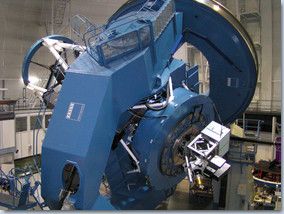 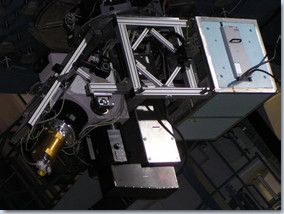
The PMAS instrument, attached to the Cassegrain focus of the 3.5-m telescope
on Calar Alto, Spain, allows the observer to obtain images and spectra simultaneously.
This is done using optical fibers, that guide the light from the telescope focal plane
to a high-performance spectrograph (click on the images for a full resolution) |
Driven by The Disk Mass Project (user login), which requires imaging spectroscopy at intermediate spectral resolution of nearly face-on galaxies, a specialized fiber-bundle, called PPAK (Pmas fiber PAcK), was designed and built at the AIP. This new integral field unit (IFU) was successfully integrated within PMAS in December 2003, and First Light was obtained on January 1st, 2004.
The PPAK unit features a central hexagonal bundle with 331 densly packed optical fibers to sample an astonomical object at 2.7 arcseconds per fiber. Six 'mini-IFUs' with alltogether 36 active fibers are positioned around these science-fibers to record the sky background. Additionally, 15 fibers can be illuminate directly by internal lamps to calibrate the instrument.
With a field-of-view of 74x65 arcseconds, PPAK currently is the world's widest integral field unit that provides a semi-contiguous regular sampling of extended astronomical objects. Its pre-optics and fiber-diameter, combined with the versatility and efficiency of the PMAS spectrograph, allows PPAK to make a unique trade-off between total light-collecting power and spectral resolution. A single large PPAK fiber collects more light even with a 3.5-m telescope than a single spatial element of an IFU mounted on a 8-m-class telescope like VIMOS on the VLT. Therefore, PPAK is ideally suited to study extended astronomical objects with low surface brightness (such as faint galaxies or gaseous nebulae), where light collecting power is more important than detailed spatial resolution.
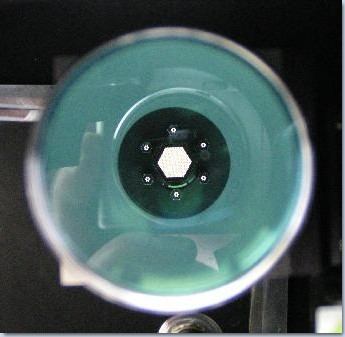
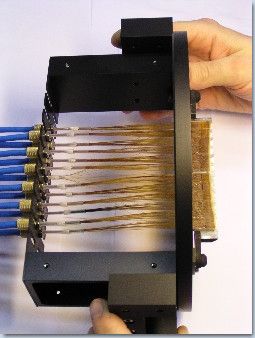
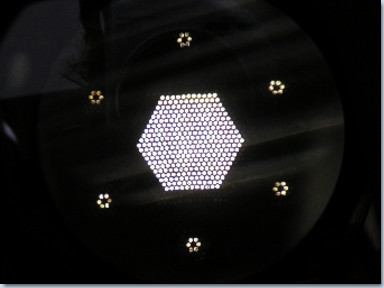

Left: Top view (through filter and pre-optics) onto the PPAK fiber bundle. 331 densly packed fibers form
the integral field unit of the central hexagonal. Additional 36 sky fibers are surrounding the central IFU.
While the physical dimension of the array is just 4 mm, its coverage on the sky is more than 1 minute of arc.
Right: At the other end, the fibers are re-arranged from the 2-dimensional configuration in the focal plane,
to a 1-dimensional fiber-slit, which is attached to the PMAS spectrograph. The sky-fibers and calibration-
fibers are placed at regular distances along the fiber-slit. |
3D Spectroscopy of Jupiter
Because of less favorable weather at the Calar Alto observatory during the night of 2004 March 21, it was not possible to study the faint galaxies of the Disk Mass observing program. Instead, the planet Jupiter was observed by AIP astronomers to demonstrate the power of 3D-observing techniques. The unusual observation of such a bright object (-2.3 magnitudes) with a 4-m-class telescope became possible only because the clouds provided sufficient attenuation as not to saturate the extremely sensitive detectors.
The PMAS instrument has the unique feature of operating two cryogenically cooled CCD cameras in parallel: the Spectrograph Camera, collecting up to 382 spectra simultaneously in one exposure, and the direct imaging A&G Camera, which is used for faint target acquisition and guiding. It is the A&G Camera which produced the direct image of Jupiter (below), while the spectrograph CCD received the light from the PPAK unit (bottom row).
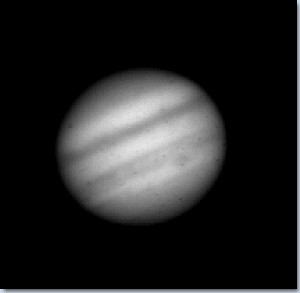
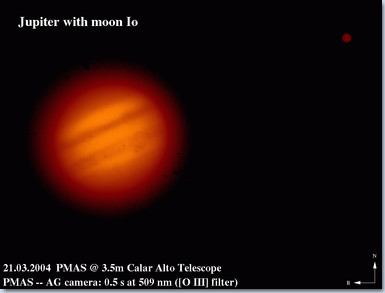
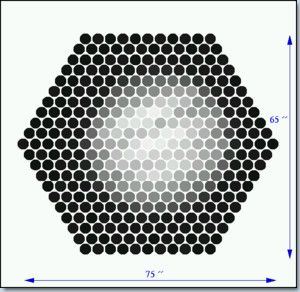
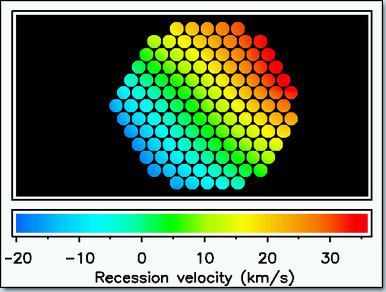 |
Top: The pictures were taken on March 21, 2004, with an exposure time of 0.5 sec and a narrow-
band filter in the green wavelength range of the optical spectrum (central wavelength 509 nm,
FWHM 10 nm). The narrow bandwidth and short exposure time (plus some clouds) were
necessary to avoid the saturation of the CCD detector. Orientation: North is up, East is left.
Lower left: Reconstructed image of Jupiter as seen by the PPAK fiber bundle. Despite the rather
coarse sampling, the cloud bands of Jupiter can be seen clearly. The apparent diameter of Jupiter of
40" at the time of the observation illustrates the wide field-of-view that is now available with PPAK.
Lower right: After the spectra have been analysed for the Doppler-shift of a reflected solar absorption
line, a velocity map of Jupiter was constructed. The rotation of the planet (blue colour for the
approaching, red for the receding side) can be easily measured.
|
Of course, this technique of imaging spectroscopy can also be applied to various other astronomical objects, such as galaxies, emission nebulae or jets.
Technical Information
| Observers: |
Dr. Marc Verheijen, Dr. Andreas Kelz (AIP)
Dr. Nicolas Cardiel (Calar Alto Observatory) |
| Telescope: |
3.5 m Telescope at Calar Alto Observatory, Cassegrain Focus |
| Imager: |
PMAS A&G Camera with B, V, R and [O III] filters |
| Pre-optics: |
Focal-reducer lens F/10 to F/3.3, platescale: 17.7"/mm |
| Integral Field Unit: |
PPAK fiber bundle (382 spectra) , FoV: 74" x 65" , 2.7"/fiber |
| Spectrograph: |
fully refractive (CaF2 optics), F/3 collimator, F/1.5 camera |
| Grating: |
spectral resolution R=8000, wavelength range 490-530 nm |
| Observing Date: |
March 21, 2004 |
References
The scientific case for the PPAK IFU is explained in:
Verheijen, M. et al., 2004, Astronomische Nachrichten, Volume 325, Number 2, pp.151-154 and astroph/0311555.
More about science projects with PMAS:
Roth, M. M. et al., 2004, Astronomische Nachrichten, Volume 325, Number 2, p. 147.
More about the PMAS instrument:
Kelz, A. et al., 2003, SPIE, Volume 4841, pp. 1057-1066.
Acknowledgements
 |
The development of PPAK was realized within the ULTROS project which is funded by the Verbundforschungsgrant 05AE2BAA/4 from the BMB+F. |
|
 |
Travel support from the Deutsche Forschungsgemeinschaft is gratefully acknowledged. |
|
 |
The PMAS operation costs are covered by AIP with funds from the Land Brandenburg. |
|
Page provided by: Andreas Kelz (AIP)
|



 last change 2004 May 9, R. Arlt
last change 2004 May 9, R. Arlt

